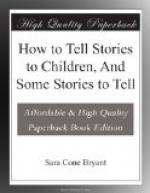I say “never” interrupt your story; perhaps it is only fair to amend that, after the fashion of dear little Marjorie Fleming, and say “never—if you can help it.” For, of course, there are exceptional occasions, and exceptional children; some latitude must be left for the decisions of good common sense acting on the issue of the moment.
The children ready, your own mood must be ready. It is desirable that the spirit of the story should be imposed upon the room from the beginning, and this result hangs on the clearness and intensity of the teller’s initiatory mood. An act of memory and of will is the requisite. The story-teller must call up—it comes with the swiftness of thought—the essential emotion of the story as he felt it first. A single volition puts him in touch with the characters and the movement of the tale. This is scarcely more than a brief and condensed reminiscence; it is the stepping back into a mood once experienced.
Let us say, for example, that the story to be told is the immortal fable of The Ugly Duckling. Before you open your lips the whole pathetic series of the little swan’s mishaps should flash across your mind,—not accurately and in detail, but blended to a composite of undeserved ignominy, of baffled innocent wonderment, and of delicious underlying satire on average views. With this is mingled the feeling of Andersen’s delicate whimsicality of style. The dear little Ugly Duckling waddles, bodily, into your consciousness, and you pity his sorrows and anticipate his triumph, before you begin.
This preliminary recognition of mood is what brings the delicious quizzical twitch to the mouth of a good raconteur who begins an anecdote the hearers know will be side-splitting. It is what makes grandmother sigh gently and look far over your heads, when her soft voice commences the story of “the little girl who lived long, long ago.” It is a natural and instinctive thing with the born story-teller; a necessary thing for anyone who will become a story-teller.




